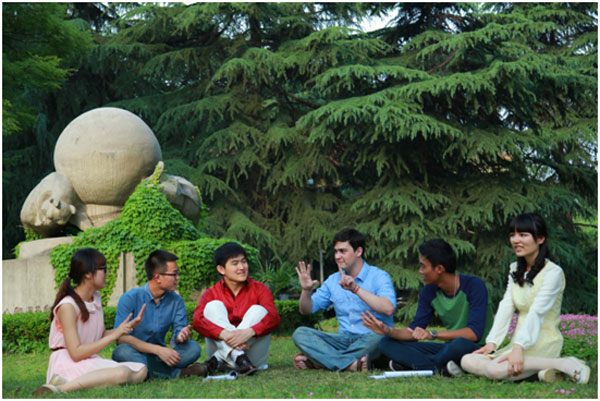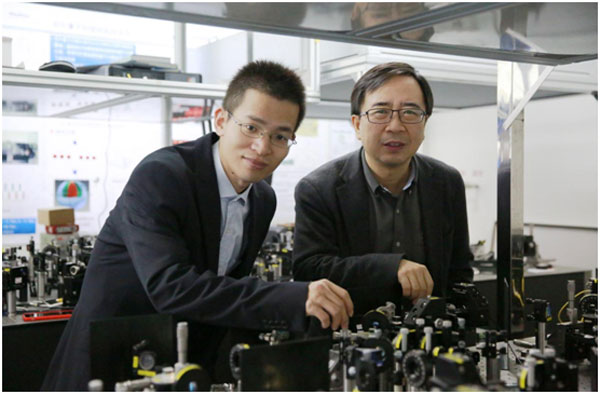

Students from home and abroad enjoy discussion at USTC. Provided to China Daily
University impresses as magnet for young researchers with international experience
In recent years, reports about Pan Jianwei and his team have often been seen on the front pages, especially since the launch of the world's first quantum experiment satellite in August.
Being a top physicist from the University of Science and Technology of China and chief scientist for the quantum satellite project, Pan has won many awards and honors since he returned from Austria's University of Vienna to his alma mater USTC in 2001.
Born in 1970, Pan was often referred to as the youngest somebody to have achieved something.
In 2011, Pan became the youngest member of the Chinese Academy of Sciences, the country's top scientific body, and the country's youngest laureate of the top prize of the State Natural Science Award earlier this year.
Most of the other members in Pan's team are also very young, with an average age of less than 40.
Behind the honors were the numerous breakthroughs he has achieved with his team, which he has built since 2001, when he returned to USTC through CAS' overseas talent recruitment plan.
"The university has benefited a lot from drawing in international talent in recent years," said Dou Xiankang, vice-president of USTC, before he left for the United States for recruiting events taking place next week.
Pan is just one of the hundreds of bright minds the university has attracted from abroad in recent years, thanks to its multiple talent recruitment plans, varying from the university-level to the state-level.
By the end of 2008, the country's top authorities initiated the Recruitment Program of Global Experts, known as the Thousand Talents Plan, to bring in top overseas talents to the Chinese mainland over the following five to 10 years.

Overseas students take part in USTC's summer camp in Hefei. Provided to China Daily
Pan was listed as one of the first batch of talents for this plan in 2008.
Among the talents the university has attracted in recent years, 44 people have been listed in the Thousand Talents Plan.
When studying and working in Austria, Pan, who is now the standing vice president of USTC, told the famous Austrian physicist Anton Zeilinger, his PhD adviser, that he dreamed of building a world-leading lab in China that is similar to Zeilinger's .
Based on their scientific strengths, Pan's team, which are often called the "Dream Team" by media, have gained a lot of support from the university, CAS and the government.
The lab that Pan built from scratch in USTC since 2001 is now world-leading in the field of quantum science and technology.
Last month, CAS and the Anhui provincial government reached an agreement to build a national laboratory for quantum information, in which Pan's team is expected to play a leading role.
The university currently houses two national labs - the National Synchrotron Radiation Laboratory and the Hefei National Laboratory for Physical Sciences at the Microscale -- the only university in the country to have more than one national laboratory, the highest level among all types of labs in the country.
The facility has since become a magnet for young scientists, attracting dozens of the country's most prominent quantum physicists. One of these individuals is Lu Chaoyang, who was singled out by the science journal Nature in June as one of the top-10 rising stars in China's science sector.

Pan Jianwei (right) and Lu Chaoyang conduct research at the University's National Synchrotron Radiation Laboratory. Provided to China Daily
Lu followed a similar education path to that of Pan. He got his bachelor's and master's degrees of USTC before moving overseas for his PhD study.
From 2008 to 2011, Lu had been studying and working in the Cavendish Laboratory at the University of Cambridge and published a paper in Nature in 2010 as the lead author. He returned to USTC in 2011.
The central authorities launched the High-level Overseas Young Talents Recruitment Plan in 2011, aimed at introducing 2,000 researchers and scientists aged around 35 from 2011 to 2015, also brought large numbers of young Chinese talent back from abroad.
This contributed to an increase in young academic leaders.
"It was Pan who encouraged Lu to do his PhD work at the University of Cambridge and convinced him to return to China with the promise that the government is investing heavily in quantum information technologies, and that bright young physicists could focus on research rather than securing funding," stated a report in Nature, citing Lu.
Today, 146 of the talents attracted by USTC have been listed in the Thousand Young Talents Plan.
The university also enjoys 116 winners of the National Science Fund for Distinguished Young Scholars, a funding program to support the country's most prominent young scientists, and 44 members of the CAS, or the county's top science body.
Among the nearly 2,000 teachers and researchers, 83 percent of them have PhD degrees, while about 70 percent are younger than 45 years old, according to the university's human resources department. (China Daily)

86-10-68597521 (day)
86-10-68597289 (night)

86-10-68511095 (day)
86-10-68512458 (night)

cas_en@cas.cn

52 Sanlihe Rd., Xicheng District,
Beijing, China (100864)

